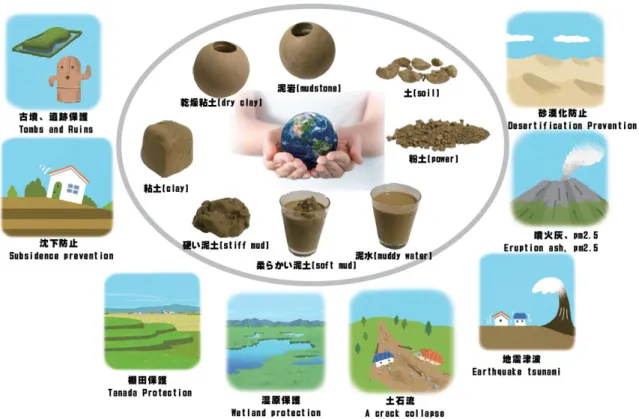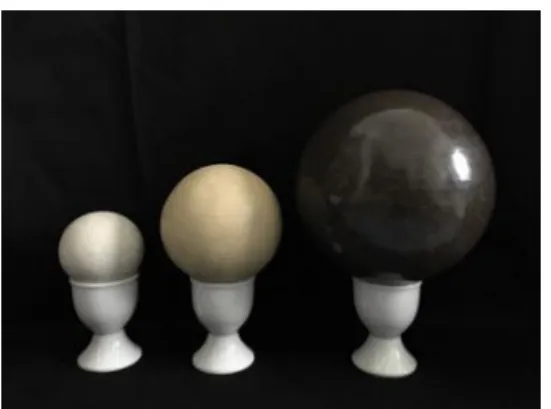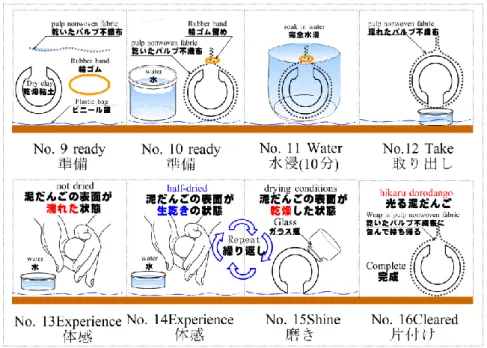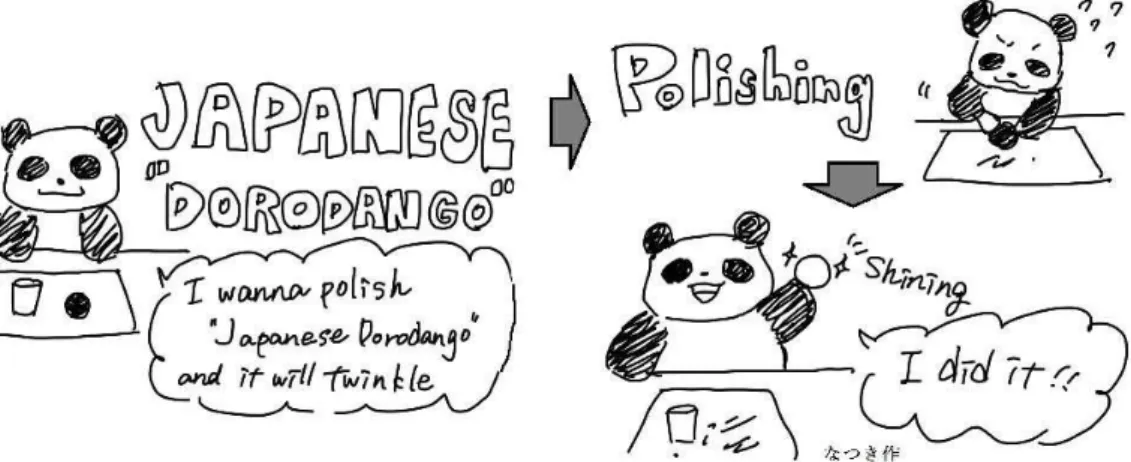Development of "SDGs Shiny Mud Ball (Dorodango)" for teaching
"Sustainable and contribution" and achievement of SDGs 4.7
by
Kiyoshi OMINE*, Katsumi MIZUNO**, Toru INUI***, Yasutaka WATANABE****, Yoshinori IWASAKI**, Masashi KAMON*****
There are few learning materials that can read the history (archive) carved in the soil and mud, look over disaster prevention education and geo-environmental problems in a single relationship diagram, and feel the feeling of the palm. Recognizing geo -environmental problems, experiencing soil and mud, revering soil and mud, and cultivating a "heart that cherishes the earth" means a skill necessary to achieve sustainable development involving SDGs. The authors conducted research and development using industrially-adjusted pottery clay to make a learning material for visiting lecture using Shiny Mud Ball to achieve Sustainable Development Goals (SDGs). "SDGs Shiny Mud Balls"
certainly enable everyone to get excitement and pleasure that shine or polish is obtained in a short period of time. "Contribution" of the SDGs can be understood by "SDGs Shiny Mud Balls".
Key words : SDGs , disaster prevention education , geo-environment, Dorodango, mud ball
1.Introduction
The authors conducted research and development using industrially-adjusted pottery clay to make a learning material of Shiny Mud Ball to achieve Sustainable Development Goals (SDGs) 1)~3). Shiny Mud Balls are a kind of soil play that can be enjoyed by toddlers and adults by shining mud ball, and are also a mud culture unique to Japan4)~8). It is also important to continue to convey Japan's unique mud culture as a learning material for the SDGs. Shiny Mud Balls are dry and spherical, polished with glass, and when they start to shine, they are drawn into their brilliance, making the work of polishing unstoppable.
A learning material for visiting lecture using dry spherical mud balls consisting of hollow and shell with a thickness of several millimeters (hereinafter referred to as SDGs Shiny Mud Ball) was developed
for adults from second graders to third graders in primary school. The learning material will contribute to mitigate disasters related to geo-environmental problems through interpretation of soil behaviors.
There are few learning materials that can read the history (archive) carved in the soil and mud, look over disaster prevention education and geo-environmental problems in a single relationship diagram, and feel the feeling of the palm.
Recognizing geo-environmental problems, experiencing soil and mud, revering soil and mud, and cultivating a "heart that cherishes the earth"
means a skill necessary to achieve sustainable development involving SDGs 5).
2.Differences between shiny mud ball and
"SDGs Shiny Mud Ball"
American craftsman William Gibson, who studied
令和元年12月27日受理
* Division of System Science, Graduate School of Engineering, Nagasaki University, Japan
** Geo Research Institute, Japan
*** Graduate School of Engineering, Osaka University, Japan
**** Central Research Institute of Electric Power Industry, Japan
***** Research Institute for Environmental Geotechnics, Japan
1
長崎大学大学院工学研究科研究報告 第50巻第94号 令和2年1月
shiny mud balls in Japan, said that "Hikaru dorodango" are balls of mud, molded by hand into perfect spheres, dried, and polished to an unbelievable luster". The technology also states that
"The process is simple, but the result makes it seem like alchemy"6).
When one of authors asked to tourists visiting Japan from abroad about the shiny mud balls, the answer was "Is it food?". Therefore, the person who had no experience of making mad balls sensuously understands it a kind of food from its appearance.
Shiny Mud Balls are captured by the image of polishing rocks with water and sand. This is because they have no experience of becoming hard like stone when dried. Because Japanese people experience mud play in early childhood, “shiny mud ball” is well known, but there are few to have an experience of shining. A perfect “shiny mud ball” work is a craft to do alone. Experiencing the radiance of a “shiny mud ball” all together is an education. This is the major difference between craft and education.
As shown in Fig.1, ''SDGs Shiny Mud Ball'' changes the states to powder, muddy water, soft mud, stiff mud, clay, dry clay, mudstone and soil in a making process for the amount of water. We can
experience the states only touch the palm.
3.Issues with shiny mud balls
Shiny mud balls using natural soil require a process of dry and wet classification of the soil, and there are few natural clays with stable quality.
Shiny mud balls require a three-step process: (1) building a core foundation, (2) coating by fine particles, and (3) polishing, so that it needs a period of several days, specifically it takes time to dry the balls. For this reason, it could not be used as learning materials in classes with time restrictions. Also, there is no technical literature describing how to make shiny mud balls relatively easy.
Photo 1 shows the newly developed ''SDGs Shiny Mud Ball''. From the left in Photo 1, the diameter of about 50 mm, 65 mm, 130 mm in the dry state. In this paper, Shiny Mud Ball with 65 mm will be described.
This will be approximately 65mm in diameter and approximately 200g in the dry state. This combines the size and weight of the palm and physical strength from fifth graders to sixth graders in primary school to adults.
"SDGs Shiny Mud Balls" is shown in Photo 2. In appearance, the ball has a hollow and the
Fig. 1 A bird's-eye view of disaster prevention education and geo-environmental issues
Photo 1 "SDGs Shiny Mud Ball" from the left in dry state diameter of 50mm (Hagi soil, white), 65mm (Okayama Bizen soil, red), 130mm (Karatsu soil)
Photo 2 "SDGs Shiny Mud Ball" with polished spherical mud ball with hollow and shell of several millimeters thick
shell, which can be used for various playing applications. SDGs Shiny Mud Balls are an advanced on the ordinal mud balls. Furthermore, it is supposed to be on-site classes with space and time constraints.
In addition, since participation of parents and children is not restricted, participation of infants is also assumed.
For this reason, infants have a basic experience of playing mud with ceramic clay.
As for the materials of "SDGs Shiny Mud Balls", 18 kinds are selected from more than 100 kinds of ceramic clay9). The 18 types of ceramic clay require some experience and familiarity, but they can all make a shiny mud ball. However, Shigaraki hand-binding clay (80 mesh) and Shigaraki koshi clay red (60 mesh) shine relatively easily in time.
Ceramic clay has a moisture content that varies from production lot to lot, ranging from 20% to 22%10). This is just hard jelly and soft jelly state, and type of
clay mineral to be used, is caused by dehydration conditions.
4.Procedures for preparation of spherical mud balls "SDGs Shiny Mud Balls" consisting of hollow and shell with a thickness of several millimeters
Figure 2 describes the manufacturing procedure for spherical mud balls "SDGs Shiny Mud Balls"
consisting of hollow and shell with a thickness of several millimeters. The procedure is as follows:
No.1: Measure weigh of clay to 260g. Store the clay in 0.1mm thick plastic bags to prevent it from drying.
No.2: Thoroughly mix to remove air. Extend the clay in the shape of a ball to a thickness of about 8mm.
No.3: Using an empty capsule (inner diameter 70mm) used for capsule toy as a mold, it is stamped to form a true sphere. Opening reinforcement increases the wall thickness by about twice.
No. 4: The opening of mud ball is plugged with a lid of an empty bottle in order to make it dense and finish beautifully. If there is a lid after shrink-drying, the opening will crack, so remove the lid at an appropriate time.
No.5: Mud balls are wrapped in non-woven pulp cloth and allowed to dry naturally until the clay is no longer plastically deformed. It is important that the upper part is hard and the lower part is soft due to moisture movement, and the sphere is kept rotating by rotating several times.
No. 6: Place a pipe socket (diameter 32mm) or shot glass on the sphere and cut it so that the gap between the sphere and the socket or glass is 0.1mm or less (the thickness of one copy sheet).
No.7: Polish with hard glass surface such as milk bottle. It can also be polished with like a porcelain tooth brush stand which has a smooth circular hollow.
It can be polished with plastic bags, but the brightness of balls’ surface will be inferior compared to that using hard glass or porcelain.
No.8: Temporarily polished mud balls are naturally dried until the whole is dried.
3
大嶺聖・水野克己・乾徹・岩崎好規・嘉門雅史
5.Materials used in the manufacture of spherical mud balls (SDGs Shiny Mud Balls) consisting of hollow and shell with a thickness of several millimeters
A commercially available clay for ceramics9) was used as a material used for manufacturing of spherical mud balls (SDGs Shiny Mud Balls) consisting of hollow and shell with a thickness of several millimeters9).
In the production of clay for ceramics, non-metallic raw materials such as porcelain stones and feldspars are pulverized and mixed, and the slurry clay in liquid form is dehydrated by pressure.
Clay of 20 kg packed in vinyl in a vacuum kneader is commercially available. Depending on the type and lot of soil, the moisture content varies, for instance, from 20% to 22% and the moisture content is not the same every time. It is important to slightly control the pressing force for polishing the surface of the ball and the drying period explained in No.7 and 8 in chapter 4. Commercial clay for ceramics is Satsuma red clay (40mesh), Karatsu clay (32mesh), Arita porcelain earth (200mesh), Hagi clay yellow (50 mesh), Hagi clay white (50mesh), Okayama Bizen red clay (50mesh), Mikage clay yellow (50mesh), Mikage clay red (50mesh), Shigaraki Koshi clay red (60mesh), Shigaraki Koshi clay white (60mesh), Iga soil fine (60mesh), Iga soil red (60mesh), black mud (40mesh), vermilion mud (60mesh), terracotta
(50mesh), Mie Banko soil red (200 mesh), Mie Banko soil white (200 mesh), Shigaraki hand-binding clay (80 mesh) and Tochigi Mashiko clay red (60 mesh) were used10). The 19 types of grain sizes indicated by the factory are classified as the grain size classification of geomaterials and their names are from 0.025 mm fine sand (32 mesh) or less to 0.07 mm silt (200 mesh).
6.The mud ball will shine if pushed hard and polished to stretch
Ceramic clays shrink and harden when dried, but swell and plastically deform when absorbed.
Rocks such as marble will become flat and shine when polished with a polishing pad.
However, ceramic clay that has been shrink-dried and hardened does not shine when polished with only a polishing pad or hard glass. The reason why the clay skin in the raw dry state is polished with glass can be explained by the micro-morphological image in the wet state (raw dry) and the micro-morphological image in press-dried state11).
Photo 3 is a fine morphological image of montmorillonite (trade name: Kunipia-F) produced in Tsukinuno, Yamagata prefecture using a controlled scanning electron microscope with low vacuum condition as in freshly dried state11).
Photo 4 is a fine morphological image of bentonite (trade name: Akagi) produced in Tomioka, Gunma Fig. 2 Manufacturing procedure for spherical mud balls (SDGs Shiny Mud Balls) consisting of hollow and
shell with a thickness of several millimeters
Photo 3 Microscopic image of montmorillonite in low vacuum condition (freshly dry)
Prefecture, using a field emission scanning electron microscope. In the press-dried state, the plane-like particles were oriented, and unevenness of surface was reduced. For this reason, if the wrinkles on the freshly dried clay surface are polished with hard glass like an iron, the clay surface becomes flat and reflects light and shines.
7.Penetration test using toothpicks
Commercial ceramic clays vary in the moisture content from 20% to 22% depending on the type of clay mineral and the state of dehydration. It is important to make clear the state that can be polished from engineering point of view and for easy understanding. Therefore, the consistency of
Photo 4 Press-dried microscopic image of bentonite
"SDGs
Shiny Mud Balls" consisting of hollow and shell with a thickness of several millimeters was measured by penetration with a toothpick. Consistency is the property that soil changes from liquid to solid depending on the water content.
A consolidation ring (inner diameter of 100 mm, height of 10 mm) for soil tests was used. While pushing in the ceramic clay of the sample, the portion protruding from the consolidation ring was cut off with a wire saw and finished to a flat surface.
The simple penetration method using a toothpick can explain the timing of polishing in the penetration depth of about 1-2 mm10). In the simple penetration method, the depth of penetration of the toothpick is measured in the process of natural drying of the Fig. 3 Penetration test results using toothpick
5
大嶺聖・水野克己・乾徹・岩崎好規・嘉門雅史
ceramic clay and the state of shrinkage hardening from plastic deformation. Opened ceramic clays varied in duration from 24 to 48 hours from plastic deformation to non-plastic deformation. The time to penetrate 5 mm or more in the non-plastic deformation state was 6 to 24 hours. It took 3 to 6 hours to penetrate about 2 to 3 mm until the surface became dry. At the same time, the range of raw drying that can be polished with glass and the timing of polishing with deep penetration were investigated, and the results are shown in Figure 3.
8.Learning procedure using the "SDGs Shiny Mud Balls"
If you present "SDGs Shiny Mud Balls" to your friends, they will be able to understand the
“Contribution” of SDGs 4.7 (Goal 4 item 7) by
“Getting the impression and joy to shine”.
Figure 4 describes the learning procedure using
"SDGs Shiny Mud Balls". The procedure is as follows:
No.9: Prepare a container to immerse the dry clay, rubber band, plastic bag, non-woven pulp cloth and
"SDGs Shiny Mud Balls" in water.
No.10: "SDGs Shiny Mud Balls" are wrapped with a non-woven pulp cloth so that water can infiltrate evenly, and then fastened with rubber bands.
No.11: Sufficiently submerge "SDGs Shiny Mud Balls" for 10 minutes. "SDGs Shiny Mud Balls"
wrapped in non-woven pulp cloth can be put in a basket and fully submerged at the same time. For this reason, group learning of about 100 people at the same time became possible.
No.12: Remove the wet non-woven pulp cloth and drain the water of "SDGs Shiny Mud Balls".
No.13: Slowly and slowly wrap around the "SDGs Shiny Mud Balls" in the palm of your hand.
No.14: After the time has passed, the mud adhering to the palm is gradually dried, and it can be observed that the surface of "SDGs Shiny Mud Balls" is coated.
This is a dry state.
No.15: Polish with a glass surface such as milk bottle or a porcelain tooth brush stand. If you continue to polish, the surface will dry and you will not be able to polish. Then, wet the wet surface with a wet cloth and return to No.14. By repeating the process of No.14 and No.15 many times, "SDGs Shiny Mud Balls" is completed.
No.16 Then, clean up your surroundings and finish your study. The learner wraps "SDGs Shiny Mud Balls" in dry non-woven pulp cloth and takes them home.
Fig. 4 Learning procedure using "SDGs Shiny Mud Balls"
9.Knowing and understanding “sustainable” and
“contribution” is the key to achieving the SDGs SDGs is an abbreviation for Sustainable Development Goals. It is a common goal set by the world leaders at a summit held at the United Nations in September 2015. The SDGs consist of “17 goals”
and “169 specific goals”. Goal 4 is “Ensure inclusive and equitable quality education and promote lifelong learning opportunities for all”. SDGs 4.7 (Goal 4 item 7) is indicated as follows:
Target 4.7: “by 2030 ensure all learners acquire knowledge and skills needed to promote sustainable development, including among others through education for sustainable development and sustainable lifestyles, human rights, gender equality, promotion of a culture of peace and non-violence, global citizenship, and appreciation of cultural diversity and of culture’s contribution to sustainable development".
It turns out that all learners know and understand
“Sustainable” and “Contribution” is the key to achieving the SDGs.
10.The case of "SDGs Shiny Mud Balls" as a learning material for SDGs 4.7
President Hiromi Hamano of Daiko Industrial Co., Ltd. carried out work experience classes to present a shiny dried spherical mud balls by the students of the Shin-Kitajima junior high school on September 26, 2019. In order to give gifts to friends in Malaysia, the students collaborated and studied using dry spherical mud balls.
Office Maker Co., Ltd. (President and CEO Akira Yoshimi) and N.S Vision Marketing Sdn.Bhd.
(President Naoki Nakamura) are planning a project to present “getting the impression and joy to shine” with Shiny Mud Balls to children of Malaysia's weak mental retardation facilities (Sekolah Kebangsaan Taman Putra Perdana) in January 2020.
11.Conclusion
To make shiny mud balls using plastically deformed clay, more than ten times of experience and time are required. "SDGs Shiny Mud Balls" certainly enable everyone to get excitement and pleasure that shine or polish is obtained in a short period of time.
"SDGs Shiny Mud Balls" is not mixed with colored clay and can be reproduced many times. For this reason, it is possible to convey the philosophy of recycling waste. In addition, sense of accomplishment to present "SDGs Shiny Mud Balls"
to your friends and give a polished shiny pleasure can be obtained, rather than to get "Self-shine excitement". "Contribution" of the SDGs can be understood by "SDGs Shiny Mud Balls". Therefore,
"SDGs Shiny Mud Balls" is a learning material of visiting lecture for SDGs 4.7 (Goal 4 item 7).
Between May 2019 and November 2019, there were eleven on-site classes using "SDGs Shiny Mud Balls" with a total of over 300 participants. It is expected that making “SDGs Shiny Mud Balls”
brings a better understanding of disaster prevention related to geo-environmental problems.
Fig. 5 Preliminary material for explanation of "SDGs Shiny Mud Balls" to friends at Malaysia
7
大嶺聖・水野克己・乾徹・岩崎好規・嘉門雅史
References 1) SDG Indicators
https://unstats.un.org/sdgs/metadata?Text=&Goal
=4&Target=4.7 (Accessed: 20 December 2019) 2) Katsumi Mizuno: Life experience that leads in
"Dorodango", "Geotechnical Engineering Journal", Vol.63 No.7 Ser No.690, 2015. (in Japanese) https://www.jiban.or.jp/file/kaishi/27-7/HP4-5.pdf 3) Yuko Yamada, Katsumi Mizuno, Tomoko Urabe
and Yasutaka Watanabe: "Doroda study of visualization through the coral" experience training, Soil mechanics and foundation engineering, Vol.63, No.1, pp.26-27, 2015 (in Japanese).
4) Nakaba Naoya: A Study Concerning with Shining Doro-Dango, Sanyo Gakuen University Bulletin,
No. 39 , Vol.39, pp77-84, 2008 (in Japanese).
https://www.jstage.jst.go.jp/article/sanyot/39/0/39_K J00005922039/_pdf/-char/en
5) Ritsuko Inami, Eiichi Imoto, Noritake Kanzaki, Sumio Kobayashi and Takanori Matsui ; The apotheosis of soil and mud, (INAX BOOKLET) (in Japanese). ISBN, 978-4-87275-821-4, 2002.
6) Hikaru Dorodango
http://www.dorodango.com/ (Accessed: 20 December 2019)
7) INAX Live Museum Saturday and mud museum experience classroom of soil
https://www.livingculture.lixil/ilm/clayworks/experi ence/ (Accessed: 20 December 2019)
8) Kyoto Professor Taps into the Essence of Play October 5, 2001
https://web-japan.org/trends01/article/011005sci_r.ht ml
9) The Ceramic Society of Japan
http://www.ceramic.or.jp/ (Accessed: 20 December 2019)
10) Asaoka Ceramic Materials Co., Ltd.
http://www.asaoka-ceram.co.jp/index.html (Accessed: 20 December 2019)
11) Katsumi Mizuno: Swelling, particle sizes, and density of twenty domestic and foreign bentonite having no JGS quality standard: Risks of evaluating the quality only by a montmorillonite content, Proc.
of the 12th JGS Symposium on Environmental Geotechnics, pp.529-536, 2017 (in Japanese).



